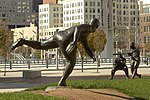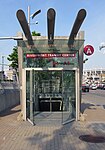Cincinnati Reds Hall of Fame and Museum
The Cincinnati Reds Hall of Fame and Museum is an entity established by Major League Baseball's Cincinnati Reds franchise that pays homage to the team's past through displays, photographs and multimedia. It was instituted in 1958 to recognize the career of former Cincinnati Reds players, managers and front-office executives. It is adjacent to Great American Ball Park on the banks of the Ohio River. Currently, the Hall of Fame section is home to 81 inductees. These inductees include players, managers & executives who were involved in Cincinnati's baseball legacy, which dates back to 1869, the year the original Cincinnati Red Stockings took the field. Inductions take place every other year.
Excerpt from the Wikipedia article Cincinnati Reds Hall of Fame and Museum (License: CC BY-SA 3.0, Authors).Cincinnati Reds Hall of Fame and Museum
Race Street, Cincinnati Central Business District
Geographical coordinates (GPS) Address Nearby Places Show on map
Geographical coordinates (GPS)
| Latitude | Longitude |
|---|---|
| N 39.09718 ° | E -84.5084 ° |
Address
Central Riverfront Garage
Race Street
45202 Cincinnati, Central Business District
Ohio, United States
Open on Google Maps










